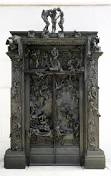The Gates of Hell at Musée Rodin..

The exhibition “Hell according to Rodin“, or “L’Enfer selon Rodin“, currently taking place at the Musée Rodin in Paris, invites the public to take a fresh look at an iconic work of art: The Gates of Hell. Over 170 works – including 60 drawings that are rarely on public display, and numerous sculptures restored for the exhibition – immerse visitors in the fascinating history of this masterpiece, which was so influential in the development of sculpture and the arts. With these mysterious, imposing doors that never open, Rodin presents a spectacular view of Hell – both feverish and tormented.
The Gates of Hell was the defining project of Rodin’s career. When, in 1880, the sculptor received the commission for what was to be an entrance for the Musée des Arts Décoratifs, he was still a relatively unknown artist. For almost a decade he threw himself into passionate research for the project, taking his inspiration initially from Dante’s “Divine Comedy“, then increasingly from Baudelaire’s “Fleurs du Mal“. Developing the architectural elements of the Gates, as much as the characters that swarm across its surface, Rodin created new forms to express human passions. In the words of the critic Gustave Geffroy, “The sculptor’s research and his found objects are visible in this triumphant creation of hands and intellect: new attitudes”.
The numerous groups and figures of the damned that Rodin designed, modelled and assembled, make up a repertoire of forms that he would re-use subsequently throughout his career, in a process of continuous renewal and reinvention. Many of the sculptor’s most well-known works came out of this creative drive that propelled him to the forefront of the artistic scene, starting with The Thinker, The Kiss, Ugolino, Danaïd and The Shades. A close examination of The Gates of Hell throws light on all Rodin’s work as it forms a summary of his stylistic experiments, and is a starting point for the many variations that stemmed from his favourite techniques: fragmentation, assemblage, enlargement, reduction, repetition, etc.
Fascinated by the human body, whether suffering, violent or erotic, Rodin continually designed, modelled and reworked his earlier creations in order to capture and to express all the impulses of the soul. The special display of over 50 “black drawings”, often annotated by Rodin, reveal this search for composition and movement. Particularly fragile and precious, these line drawings, highlighted with washes of ink and of gouache are rarely exhibited. Around thirty sculptures, specially restored for the exhibition, are displayed for the first time.
The exhibition extends into the museum’s sculpture garden, where there is a bronze version of the
Gates. Also as a complement to this fascinating exhibition, the Musée Rodin is hosting a “Journée d’étude” on Friday the 18th of November, from 9:30 a.m. to 6 p.m., entitled “La Porte de l’Enfer“, which will have many distinguished scholars discussing various aspects of his majestic work.
The morning session, entitled “Context and sources of inspiration of the Gates of Hell“, introduced by Catherine Chevillot, the Director of the Musée Rodin, will commence with a presentation by Professor Aida Audeh of Hamline University in the U.S., who’s discussion will examine: “Rodin’s Gates of Hell in Context: Dante and Nineteenth-Century French Art“.
The afternoon session, entitled “What does the Gates of Hell show us and what does it say?“, is headed by a presentation by Olivier Schuwer from the Sorbonne discussing: “Il n’y a pas de littérature là-dedans” : l’ombre du symbolisme sur La Porte de l’Enfer”.
L’Enfer selon Rodin exhibition, at the Musée Rodin, will run until the 22nd of January 2017.
Journée d’études: La Porte de l’Enfer
Auditorium du musée Rodin
21 bd des Invalides 75007 Paris
Vendredi 18 novembre, de 9h30 à 18h00

